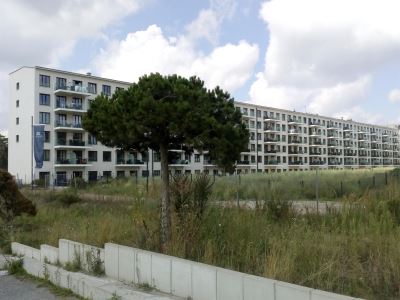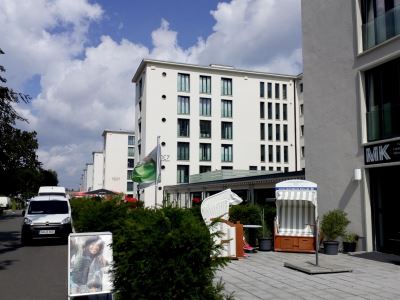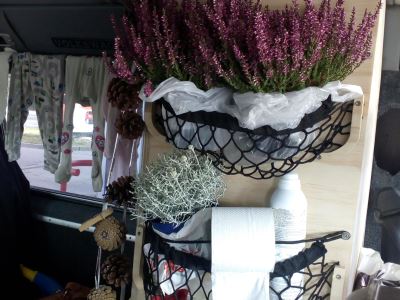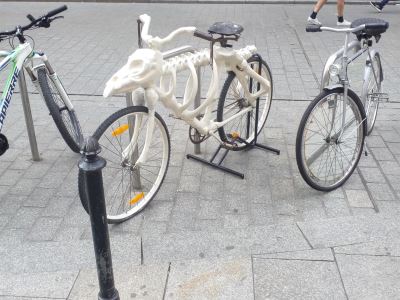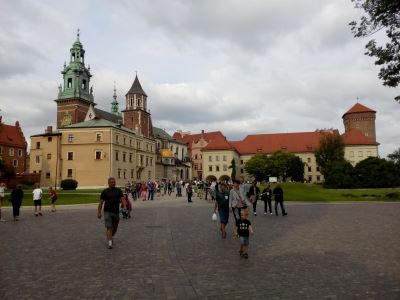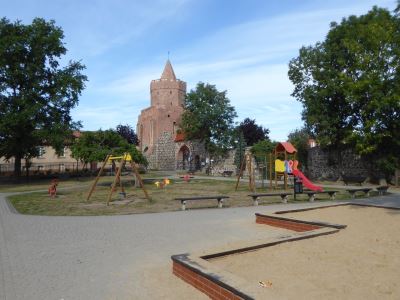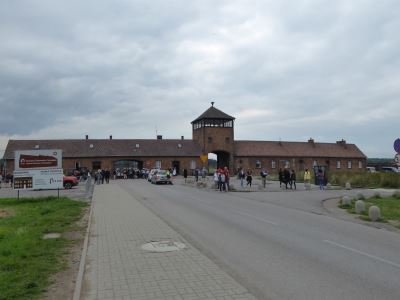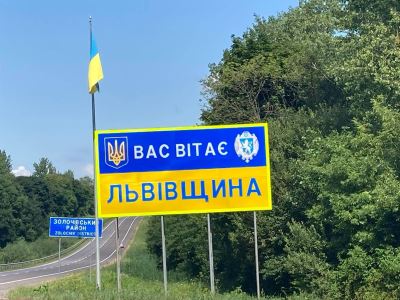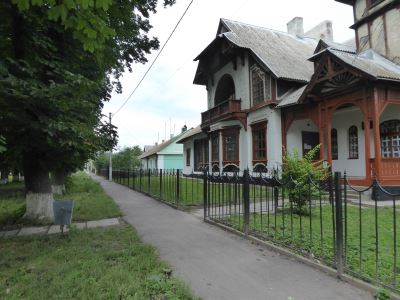Home sweet home – a road trip from Denmark to Ukraine
In the last travelling blog, we drove to Denmark. We went through Slovakia, Czechia and Germany, and the trip lasted 11 days. Going back to Ukraine, we will take the ferry to Rostock in the northern part of Germany. This will save us hundreds of km of driving, compared to the route we used to get here. So a Sunday late afternoon in August, we boarded the ferry in Denmark, which should take us to Rostock in Germany. Our first planned destination was the German Island Rügen. I wanted to visit Rügen so I could finally see the Prora “holiday resort” that was built by Hitler in the end of the 1930ties. The resort was a project by the “Kraft durch Freude” (Strength Through Joy) organization that was Nazi Germanys leisure organization. The Prora resort should accommodate 20.000 people at the same time. This giant resort was never fully finished, but is still impressive with buildings occupying 3 km of the coast line.
I have had the Prora on my “must see” list for many years. When I added it to my mental list, it was a worn down, abandoned place. Only a very little part of the buildings had been renovated and used for a youth hostel.
We drove across Rügen, it was already dark. The roads were pretty narrow and we hardly saw any cars. I had checked Google maps and could see that there was a road next to the buildings, and I naively thought we could park there next to the old abandoned buildings (and secretly thinking: “if it is not too scary…😊”). When we arrived, I couldn’t get to the buildings because the road was blocked by a barrier and in front of us there was a huge parking lot. I started to understand that maybe this place wasn’t so abandoned after all.
We turned around and found a little parking lot next to the train station. It was not a perfect camp spot, but we were tired and everything seemed quiet.
If there were any trains during the night, I didn’t pay attention to them and the next morning we drove a little around (just to find out that all roads leading to the Prora resort were closed with a barrier). After some food shopping in the nearby town Binz, we drove back to the parking lot that we had discovered the night before, because this was also where the museum about the history of the resort was.
I went alone to the museum. My wife doesn’t understand German and somebody had to take care of our daughter. After I had spent an hour in the museum, I was ready to give my family a guided tour 😊
The part of the resort that we could see from the parking lot looked old, but it was protected by fences and was clearly a construction site so we went to the beach.

It is a very nice beach so it is clear why the Nazis decided to build the resort here.

Almost the entire complex had been renovated and now the entire area looked like all other German seaside areas that I have seen: Beautiful and expensive.
So all in all I was a bit disappointed. I had expected an abandoned place, but the construction workers had been working hard and almost the entire complex looked new and shiny.
A month ago, I had watched a German travelling program about Rügen and knew that there should be a “tree top” walking path. When I watched the program I thought: “Cool”, but hadn’t checked exactly where it was located. But just a few km away from the Prora resort, we saw a very tall wooden construction between the trees (and a big parking lot full of cars) so we stopped there and decided to check it out.
It was well worth the visit. Our one-year-old daughter had just started to walk and found the tree top walk very interesting and so did her parents.


It was a nice little town located next to a lake. My wife bought some plants and after that the inside of the car looked like this.

We spent the night at a parking lot in a little town next to the main road. It was not an ideal camp spot. I prefer not to be visible to everyone that drives by, since that increases the odds that somebody with bad intentions will see us. Until now, I never had any problems, but travelling in a 33-year-old van with Ukrainian license plates probably doesn’t make you the most obvious victim.
Another place on my list of “must see” places is the Auschwitz Concentration Camp located in the South of Poland. There is a museum as well as the actual camp Auschwitz II-Birkenau. The two locations are about 2 km apart. We went to the museum first. My wife has already long time ago declared that this is not for her. She doesn’t want to see it. Again someone has to babysit, so I leave my wife and my daughter in the van – it is time to get a nap while I try to find out how to enter the museum. It is full of people and there is a big line of people waiting to buy tickets. At this time of day it is not possible to just look at the museum on your own, you have to take part in a guided tour. I decide to go and check out the camp instead. I don’t want to disturb the girls, who might be asleep by now, and I decide to walk the 2 km to the camp.

And the railroad that was used to transport so many people to their death.
I walk back to the museum’s parking lot. Here I get engaged in a conversation, first with a German couple who is travelling with their little son (around two years old) in a rented VW van about 30 years newer than ours. It is written on the side of it that it is CO2 neutral and this is my opening line when I start the conversation because I can’t understand how it can be CO2 neutral. It looks like an ordinary diesel car. The man tells me that when you rent the car, you also pay to offset your CO2 usage e.g. by planting trees while the car itself is just an ordinary diesel. I ask him if he has visited the museum and he says yes. “How was it” I ask. “Interesting and very depressing” he answers. We have a nice little chat until they have to leave. They are heading for Krakow that is also our goal for the night.
Before I started to talk to the German couple, an elderly couple stopped in front of our car and asked if we really were from Ukraine. I didn’t really notice what language he asked in, but I answered in German, which he clearly mastered. But somehow he didn’t seem to be a native. I got a bit distracted and they left again. When I see them walk by the second time, I stop them and ask them where they come from. They have lived in Germany for more than 20 years, but are originally from Moscow. In my best Russian I ask my wife if she wants to join us and speak some Russian, and we have a nice little chat in German and Russian. They are both retired and are travelling around in their camper. They say they envy us because our car is so compact. They can’t just park where they want to because their camper is so big. I ask them if they have been to Russia with the camper and they reply that they haven’t. It is too complicated with visa and such and they are also not sure if it safe there.
I have decided that I don’t want to visit the museum. The camp was depressing enough, but I insist that we go there one more time so my wife can also see it. It is after all the memorial of the biggest tragedy in European modern history.
After the camp we drive to Krakow. I have researched a little about campsites, but after studying the map, I think I can find a parking spot much closer to the center of the city than what any of the campsites can offer. On the outskirts of Krakow, we stop to buy food and eat and then we drive into Krakow. We find a nice camp spot next to a little park a few hundred meters from the Vistula River where there is a little path. Another 1.5 km of walking and we are already in the old town. I have never been to Krakow before, but I have heard a lot of positive things about it. It is not as impressive as Prague, but less crowded and we enjoy a day there.
We saw this interesting bike in Krakow
It is Thursday afternoon and we are 250 km from the Ukrainian border. The border crossing we are going to use is (probably) the busiest between Ukraine and Poland. I assume that Friday is probably the busiest day of the week when a lot of the Ukrainians that work in Poland want to go home for the weekend, so I decide that it would be a great idea to get to the border before Friday.
We drive most of the evening and arrive at the border at midnight. We didn’t take the highway, but used the major road that runs almost parallel with the highway (my car is so slow that I don’t benefit from the maximum speed on the highway, and the main roads are more interesting to drive because you see a bit more of the country). On the road there was almost no traffic. Just before the border, the traffic from the main road is led on to the highway, but after a few km (where we also don’t see any cars) the road is suddenly blocked from loads and loads of cars waiting to cross the border.
When we left Ukraine, we learned that children on board gives you VIP treatment on the border so my wife gets out of the car and starts to walk toward the end of the line of cars. Just after she leaves, my daughter starts to scream VERY LOUD. So we get out of the car and climb into the back were the bed is ready. Just as I get her calmed down, the cars in front of us start to move. When I don’t move, the 5 cars that have joined the line after we arrived starts to overtake us. Hmm great. How will we ever get to the end of this line… We get in to the driving seat again and then I see my wife. She has the good news that we should just drive to the end of the line where a barrier closes the road, leading to the border area. The Polish border guys take our passports and when the barrier goes up the next time, we get the passports back and are told that we should take the lane for EU cars. In this lane there is only one other car and very soon we have left the European Union. On the Ukrainian side our luck has run out. The passport control doesn’t work in the line we are standing in. After 10 min of waiting, an officer arrives and I get the first stamp. She tells me to go to the next window where the customs are sitting. Here is also no one and when I go back to the passport control again and tell this, the officer just repeats, irritated, that I should go to the next window. After a bit of waiting, a guy arrives, but he doesn’t want to help me. He just points to another line and tell me to go over there. In this line, everybody has a bunch of papers (I just have little piece of paper that needs two stamps, one from the passport control and one from the customs, before I can enter Ukraine). It takes 3-5 minutes for the officer to process each of the waiting people. I get a little nervous because why do all those other people have so many (important?) papers. On the booth were the officer sits, there is a sample document that tells how to fill out an import declaration. I have nothing to declare, I think. Then it is finally my turn. I give the officer our passports and the little piece of paper that he should stamp. He asks in Ukrainian : “Where is your car?” – “There!” I show with my hand. “What do you have in your car?”. “Stuff for travelling”, I reply. He stamps my paper and we can finally enter Ukraine.
It is now two in the morning (we just lost an hour because of the change of time zone). In general, it is not a good idea to drive when it is dark in Ukraine if you like your car (and want it to remain in good condition) and don’t know the road condition. But we can’t find anywhere to stop so I just keep going. I am beyond the point where I can sleep. We continue into Lviv where I hope we can find a place to sleep, but it is not until 70 km after Lviv that we find a good place to sleep in a little town. We are now less than 200 km from home, but it is also almost 5 in the morning so we say goodnight. After a few hours of sleep, I go out to organize some breakfast. There are two shops next to us, but the only thing interesting is a couple of bananas. Together with a cup of tea this is our breakfast. Just after lunch, we arrive at home. We spent “just” 5 days to get home, which was about 1600 km of driving, whereas the trip to Denmark took us 11 days, but we also drove 2500 km. All in all, I am very happy with this trip. Most of all, I am surprised that the old car didn’t break down 😊
Though the transmission, that I bought used half a year ago, is showing signs of wear and the first gear doesn’t always want to engage the first (or second or sometime third) time, which is a bit stressful inside town. But we made it back home and I enjoyed every km.


